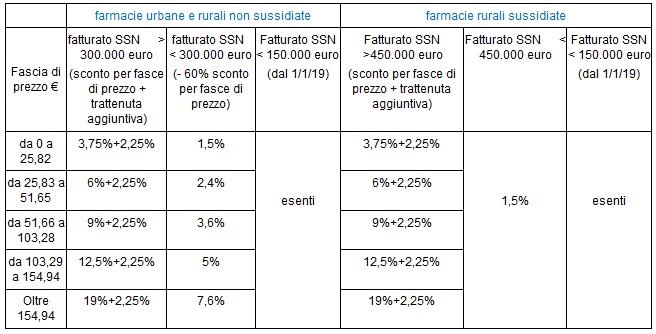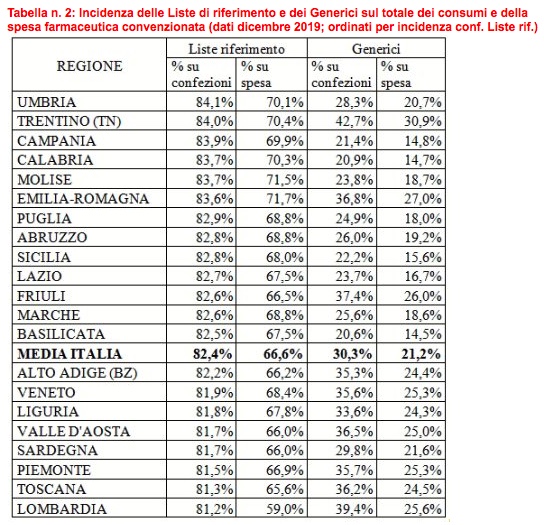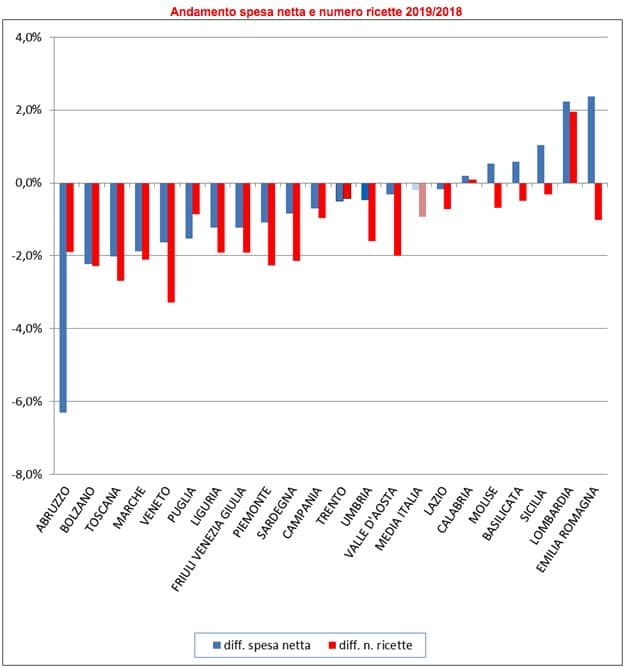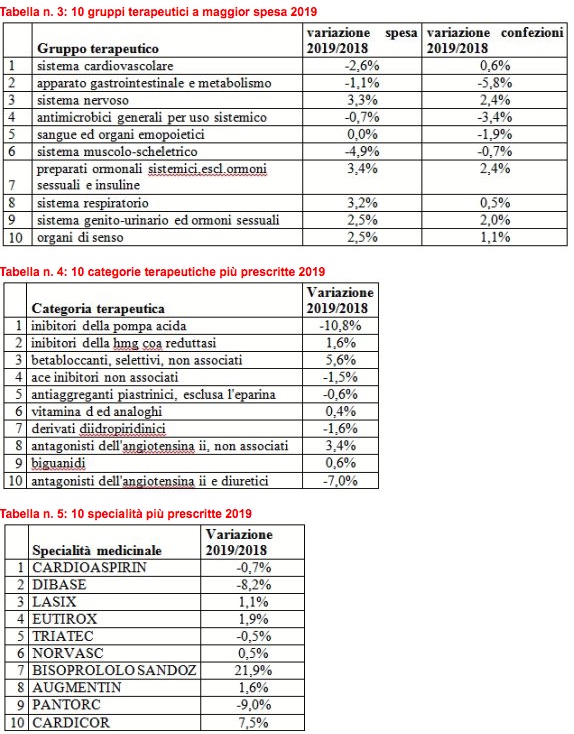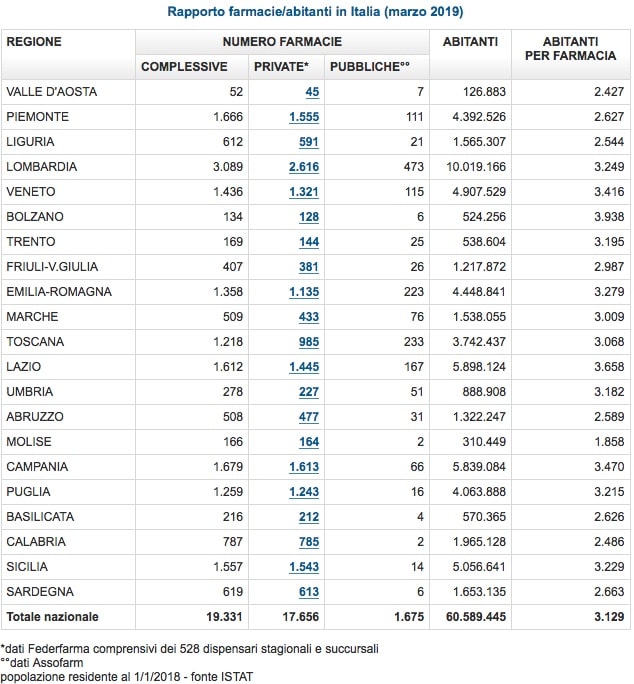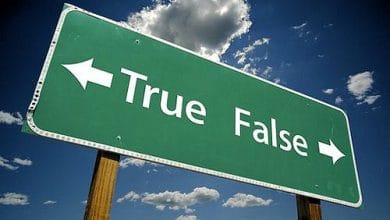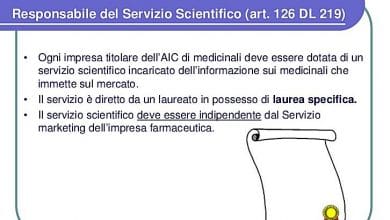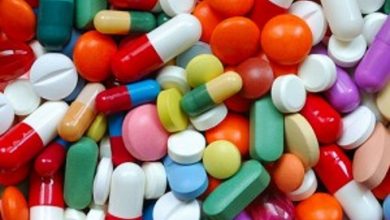
EXPENDITURE DATA JANUARY-DECEMBER 2019
NHS net pharmaceutical spending also registered in 2019 a decrease of -0.2% compared to 2018. The trend of reduction in expenditure for drugs dispensed by pharmacies under the normal conventional regime therefore continues, with a monthly trend, however, differentiated within the six-month period and at regional level. In 2019, the decrease overall average expenditure was determined by a -0.9% decrease in the number of NHS prescriptions, partially offset by an increase in the average prescription value (net +0.8%; gross +0.5%), resulting from an increase in average price of conventionally prescribed drugs (+0.5%).
In 2019, there were over 571 million prescriptions, equal to an average of 9.46 prescriptions for each citizen. There were almost one billion and 100 million packs of medicines supplied by the NHS (-0.9% compared to 2018). Every Italian citizen collected an average of 18.2 packs of medicines from the pharmacy at the expense of the NHS, with an average price of 9.26 euros.
THE CONTRIBUTION OF PHARMACIES TO COST CONTAINMENT
Pharmacies continue to make a significant contribution to cost containment - in addition to the dissemination of equivalents and the free provision of all data on NHS drugs - with the discount by price range, which led to a reduction in net spending in 2019 of over 320 million euros, to which must be added over 64 million euros deriving from the portion of the 0.64% of the so-called pay-back, charged to pharmacies starting from 1 March 2007 and always extended, aimed at compensating for the failure to reduce of 5% in the price of a number of medicines. To these heavy charges was added, from 31 July 2010, the withholding of 1.82% on pharmaceutical expenditure, increased, from July 2012, to 2.25%. This additional deduction resulted in a cost for pharmacies quantifiable in 2019 at over 181 million euros. Overall, therefore, the direct contribution of pharmacies to containing expenditure, in 2019, was over 566 million euros.
It should be remembered that the discounts by price range charged to pharmacies are progressive in that they increase as the price of the drug increases, causing the pharmacy's real margins to be regressive with respect to the price. Subsidized rural pharmacies and small pharmacies with low turnover NHS (whose limits have been updated as from 1 January 2018) enjoy a reduction in the discount due to the NHS, while from 1 January 2019 pharmacies have been exempted from discounts with annual NHS turnover of less than €150,000 (see table no. 1).
PARTICIPATION FEE PAID BY CITIZENS
The participation fees paid by citizens decreased by -1.6% compared to 2018, with an average incidence of 15.3% on gross expenditure, with peaks reaching up to 19.6% in Campania and 19.2% in Veneto .
Overall, citizens paid more than 1,500 million euros in drug shares, of which more than 70% (AIFA data) due to the difference in price compared to the reimbursement value, having requested a more expensive drug.
For an overview of the tickets applied by the individual Regions see the website www.federfarma.it under the heading “regional tickets”.
INCIDENCE OF REFERENCE LISTS AND GENERALS
The incidence of drugs included in the AIFA reference lists remains substantially stable at the national average level following the expiry of the patent for branded drugs. At national level, the incidence of expired patent drug packages on the total number of packages dispensed under the NHS, in December 2019, was equal to 82.4% (it was 82.5% in December 2018), while the related expenditure was equal to 66.6%% of the total (66.68% in December 2018).
On the other hand, the incidence of generic packs increased slightly, amounting to 30.3% (29.9% in December 2018) of the total for an expenditure equal to 21.2% of the total (20.5% in December 2018), with notable differences at the regional level, as can be seen from table no. 2 which follows.
THE TREND OF EXPENDITURE AT THE REGIONAL LEVEL
The drop in spending is particularly evident in Abruzzo (-6.3%), followed by the province of Bolzano (-2.2%), Tuscany (-2%), Marche (-1.9%). Spending is on the rise in Emilia-Romagna (+2.4%), Lombardy (+2.2%), Sicily (+1%), Basilicata (+0.6%), Molise (+0.5%), Calabria (+ 0.2%).
NHS DRUG CONSUMPTION IN 2019
Once again in 2019, drugs for the cardiovascular system confirmed their place as the category with the highest expenditure (see table No. 3), despite showing a drop in expenditure (-2.6%), against a limited increase in consumption (+0 ,6%), following the prescription of drugs that are on average less expensive, as the patent has expired.
Among the 10 most prescribed categories of drugs (see table no. 4) also in 2019 acid pump inhibitors (drugs for gastritis, ulcers, gastric reflux) are in first place, despite recording a significant drop in consumption (-10 ,8% compared to 2018). Within the category of antihypertensive drugs, the prescriptions of beta-blockers (+5.6%) are on the increase. On the other hand, the growth in vitamin D consumption is slowing down (+0.4% compared to 2018).
The most prescribed medicinal product (see table no. 5) continues to be cardioaspirin® (antiplatelet drug; -0.7% compared to 2018), followed by dibase® (drug for vitamin D deficiencies; -8.2%). The consumption of branded drugs for the gastrointestinal tract (pantorc® -9%) is significantly decreasing, while those of bisoprol (+21.9%) and cardicor® (+7.5%), both beta-blockers, are increasing.
AIFA 2019 MONITORING DATA
On this occasion, it should be noted that AIFa has published the data from the monitoring of pharmaceutical expenditure in 2019.
From these data it emerges that the pharmaceutical expenditure under the agreement, also in 2019, stood below the planned expenditure ceiling (7.96% of the FSN), with a difference of -913.71 million euros. On the other hand, the uncontrolled increase in pharmaceutical expenditure for direct purchases by public structures continues which, in 2019, recorded an overrun of 2.6 billion euros compared to the ceiling of 6.69%.
This confirms the fact, publicly highlighted by Federfarma with its own press release dated May 22, 2020, that interventions are needed to enhance the professional role and extend the monitoring guaranteed by pharmacies to a greater number of medicines (in particular those currently distributed directly by the ASL), in order to guarantee transparency and control of spending.
Federfarma – pharmaceutical spending


